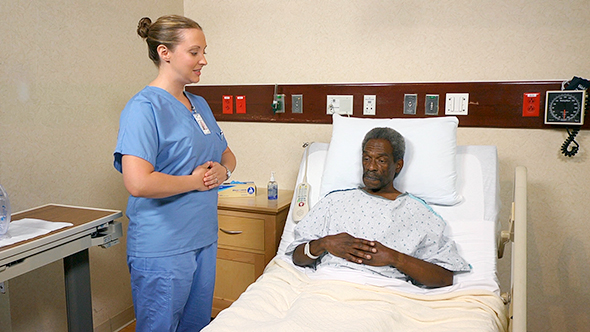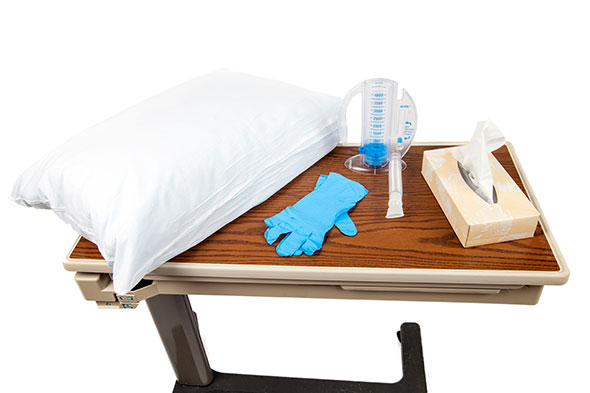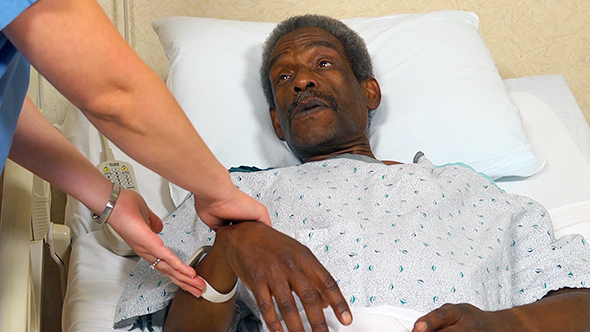Specimen Collection and Surgical Care
Select a Skill:
- » Collecting a Midstream Specimen
- » Collecting a 24-Hour Urine Specimen
- » Collecting and Testing a Stool Specimen
- » Collecting a Sputum Specimen
- » Measuring Blood Glucose
- » The Surgical Skin Prep—Shaving the Skin
- » Assisting with Deep Breathing and Coughing Exercises
Take the Review Test:

Purpose

- Deep breathing moves air into most parts of the lungs. Coughing removes mucus.
- Deep-breathing and coughing exercises promote oxygenation. They are done after surgery or injury and during bedrest. The exercises are painful after surgery or injury. Breaking an incision open while coughing is a fear.
- Deep breathing and coughing are usually done every 1 to 2 hours while the person is awake. They help prevent pneumonia and atelectasis (partial collapse of the lung).
- Atelectasis occurs when mucus collects in the airway. Air cannot get to a part of the lung. The lung collapses. Surgery, bedrest, lung diseases, and paralysis are risk factors.
- Incentive spirometry may be used along with deep breathing exercises. With incentive spirometry, the person inhales until reaching a pre-set volume of air. Balls or bars in the device move as the person inhales.
- Incentive spirometry also is called sustained maximal inspiration (SMI). SMI means inhaling as deeply as possible and holding the breath for a certain time, usually at least 3 seconds.
Equipment
Roll cursor over items to see labels. For the purposes of clearly depicting the equipment, a barrier is not shown in this photo. When providing care, a barrier should always be placed on the surface before placing the equipment.

Pillow
Gloves
Incentive spirometer, if ordered
Tissues
Delegation
- Follow delegation guidelines. Before assisting with deep breathing and coughing exercises, obtain this information from the nurse and care plan:
- When to do them and how often
- How many deep breaths and coughs the person needs to do
- What observations to report and record
- When to report observations
- What patient or resident concerns to report at once
- Before assisting with incentive spirometry, obtain this information from the nurse and care plan:
- How often the person needs incentive spirometry
- How many breaths the person needs to take
- The desired height of the floating balls
- How to clean the mouthpiece
- When to replace the mouthpiece
- What observations to report and record
- When to report observations
- What patient or resident concerns to report at once
Preparation

- Observe quality-of-life measures.
- Review the information under Delegation and Safety and Comfort.
- Practice hand hygiene.
- Identify the person. Check the ID bracelet against the assignment sheet. Also call the person by name.
- Provide for privacy.
Safety

- Respiratory hygiene and cough etiquette are needed if the person has a productive cough. The person needs to:
- Cover the nose and mouth when coughing or sneezing.
- Use tissues to contain respiratory secretions.
- Dispose of tissues in the nearest waste container after use.
- Wash his or her hands after coughing or contact with respiratory secretions.
- While the person is covering the nose and mouth, you need to splint his or her incision with your hands or a pillow. Make sure you wear gloves to splint the incision.
Comfort
- This skill does not include comfort content.
Procedure Video
Audio Description: OFFFollow-up Care

- Provide for comfort.
- Place the call light within reach.
- Raise or lower the bed rails. Follow the care plan.
- Unscreen the person.
- Complete a safety check of the room.
- Practice hand hygiene.
Reporting/Recording
- Report and record your observations related to deep breathing and coughing, including:
- The number of deep breaths and coughs
- How the person tolerated the procedure
- Report and record your observations related to incentive spirometry, including:
- How many breaths the person took
- The height of the floating balls
- If the person coughed after using the spirometer
- How the person tolerated the incentive spirometry
Review Questions
Select the best answer.
1. What is the purpose of deep breathing and coughing exercises?
 To treat diseases of the respiratory tract
To treat diseases of the respiratory tract To decrease the need for oxygen therapy
To decrease the need for oxygen therapy To eliminate the use of an incentive spirometer
To eliminate the use of an incentive spirometer To move air into most parts of the lungs and remove mucus
To move air into most parts of the lungs and remove mucus
Select the best answer.
2. Which patient position is appropriate for performing deep breathing and coughing exercises?
Select the best answer.
3. How often should a person on bedrest perform deep breathing and coughing exercises?
 Every 1 to 2 hours while awake
Every 1 to 2 hours while awake Every 4 to 6 hours around the clock
Every 4 to 6 hours around the clock As often as the person feels able to perform them
As often as the person feels able to perform them Twice a day—once in the morning and once in the evening
Twice a day—once in the morning and once in the evening
Select the best answer.
4. When using an incentive spirometer, the person should receive which instruction?
 Inhale slowly, hold for 3 to 5 seconds, place the lips around the mouthpiece, and exhale forcefully.
Inhale slowly, hold for 3 to 5 seconds, place the lips around the mouthpiece, and exhale forcefully. Place the lips around the mouthpiece, exhale slowly, hold for 5 to 8 seconds, and inhale slowly.
Place the lips around the mouthpiece, exhale slowly, hold for 5 to 8 seconds, and inhale slowly. Place the lips around the mouthpiece, exhale forcefully, hold for 4 to 6 seconds, and inhale slowly.
Place the lips around the mouthpiece, exhale forcefully, hold for 4 to 6 seconds, and inhale slowly. Exhale normally, place the lips around the mouthpiece, inhale slowly, hold for 3 to 6 seconds, and exhale slowly.
Exhale normally, place the lips around the mouthpiece, inhale slowly, hold for 3 to 6 seconds, and exhale slowly.
Select the best answer.
5. During deep breathing exercises, how long should the person hold each inhalation?
You have completed the Review Questions for this skill. To take the Review again select the Start Over button. To proceed to another skill select from the dropdown menu. Select the Home or Back button to proceed to the next section.

